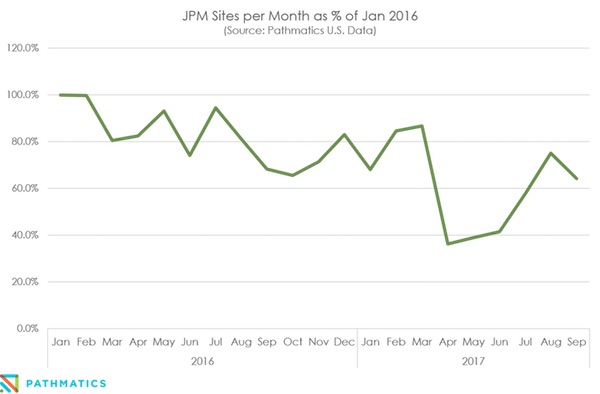After cutting back site list in March, JPMorgan Chase has doubled the number of sites it advertises on in the past six months
JPMorgan Chase became a cause célèbre for brand safety after The New York Times reported in March that the mega bank drastically reduced the number of sites it ran ads on from 400,000 websites a month to 5,000 sites a month. But since the Times report, the bank has increased the number of sites it runs ads on.
The company declined an interview request, but a JPMorgan Chase spokesperson said the brand now runs ads on about 10,000 websites — still just 2.5 percent of its original, impossibly broad site list. Ad tracking firms show a similar trajectory. Although the company’s ads appear on more sites now than they did in the spring, the bank still runs ads in far fewer places than it did a year ago. What this indicates is that despite how they’re talked about at industry conferences, brand-safety tactics are malleable.
“The whole strategy is probably more fluid than the firm stance that has been talked and written about,” said Ken Van Every, senior business development manager at programmatic buying platform DataXu. “But the end goal is still the same, and it’s a good one to protect their brand.”
After the number of sites with Chase ads cratered in March and April, the brand saw a 50 percent increase in the number of sites it ran ads on in May, according to MediaRadar, which declined to share raw numbers. Since May, there has been a steady uptick in the number of sites with Chase ads, but the growth has slowed significantly. In August, Chase ads ran on only 6 percent more sites than they did in July, according to MediaRadar.
As seen in the chart below, which shows month-to-month percentage changes in the number of sites Chase has ads on, Pathmatics data also indicates the bank is running ads in more places since the Times report came out.

After the Times story began making the rounds within the media industry, the bank probably received a barrage of requests from publishers requesting that their sites be included on its whitelist, Van Every said. The expansion of the number of sites Chase runs ads on was likely an accommodation of these requests. Although cheap reach is appealing to most brands, a doubling of sites doesn’t necessarily increase reach by that much since the most popular sites (most of which were likely already included in Chase’s campaigns) have exponentially more traffic and inventory than long-tail sites, Van Every said.
Ad position: web_incontent_pos1
Marc Goldberg, CEO of brand-safety firm Trust Metrics, said whitelists and blacklists need regular monitoring and updating in order to be effective, so it’s not that surprising to a see brand open up its campaigns to more sites after testing a new strategy.
“Neither a whitelist or blacklist is a static document designed to set and forget,” he said.
More in Marketing

In the marketing world, anime is following in the footsteps of gaming
As marketers look to take advantage of anime’s entry into the zeitgeist, they might be wise to observe the parallels between the evolution of anime as a marketing channel and the ways brands have learned to better leverage gaming in recent years.

With the introduction of video ads and e-commerce, Roblox looks to attain platform status
Roblox is expanding into more areas than just ads in 2024. Much like platforms such as Amazon and Facebook have transcended their origins to evolve from their origins as online marketplaces and social media channels, Roblox is in the midst of a transformation into a platform for all elements of users’ virtual lives.

PepsiCo wants to remain a ‘driver of culture’ as it turns to influencers and activations amid rebrand
The soda-maker says it can translate cultural relevance into sales volume.
Ad position: web_bfu
